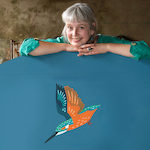
Going with the flow, for a career in fish conservation
While studying Zoology at a Galway university, Dr Tara Gallagher had no endgame in mind. She certainly hadn’t envisaged working in the area of fish conservation. Unlike some of her colleagues who are keen anglers, she wasn’t initially drawn to a career in this area. In her own words, she “fell into it.”
Fortunately, Tara landed on her feet, with a job at Inland Fisheries Ireland; the state agency for protecting, managing and conserving inland fisheries and sea angling resources. Work here involved Tara in many aspects of freshwater ecology, including water quality, aquatic invertebrates and aquatic plants. Currently, she monitors lesser-known and rare fish species across Ireland to assess their conservation status and how well conservation measures are working.
“I work on these really interesting species: lamprey, shad and smelt. Lamprey are particularly fascinating, having existed unchanged for millions of years.”

A netted River Lamprey. Credit: Tony Brett, Inland Fisheries Ireland.
“There’s a good mixture of outdoor and indoor work, so it never gets boring.”
Fieldwork takes place from March to November and the monitoring is varied.
“We carry out different types of surveys for the different life stages of these species. For instance, kick sampling for shad eggs, electrofishing for juvenile lamprey and identifying lamprey redds (nests) on shallow, fast-flowing river beds.”
The rest of the year is spent compiling reports.
Opportunities were limited when Tara left college, making it difficult to plan a career. Positions for zoology graduates in Ireland were thin on the ground. A broad, general interest in biology and environmental science gave Tara flexibility when job hunting. Luckily, she adds, things are changing for the better. Growing public awareness around biodiversity loss is driving government policy to further protect our natural heritage.
Volunteering and internships have been important stepping stones for Tara. For many years she conducted countryside bird surveys for Birdwatch Ireland. These gave her invaluable experience around surveying and data collating, relevant to the fieldwork she carries out today.
Throughout her career, Tara has seen wildlife conservation expand into areas beyond biology. More advanced and efficient monitoring methods continue to evolve alongside mainstream technology. Different skillsets come into play for activities such as:
- Drone technology
- Environmental DNA (eDNA). Tara and her team can send water samples to be analysed by a biochemist to detect the presence of lamprey DNA.
- Telemetry. Used to electronically transmit data from sensors in tagged fish to keep track of their movements.

Tagging Shad to monitor its movements.
Gathering information to write reports, she admits, can seem somewhat routine, but it helps to remember that this work is the precursor to positive and wide-reaching change. Under the EU Habitats Directive, Inland Fisheries Ireland monitors protected fish species in Ireland and reports on their status.
The National Parks and Wildlife Service is part of the Irish Government department that oversees, among other things, Wildlife Acts and EU Directive transposition such as Article 17 reports.
“We tend to forget about the big picture. At times you feel that this monitoring is not important. But to maintain or improve wildlife habitats and species you have to know what the trends are.”
The collated data inform annual advisory reports which are made available to anyone with an interest in our natural environment, such as NGOs, the general public, politicians and government departments. These reports then feed into a European composite report, ‘The State of Nature’, which is published every six years.

Dr Tara Gallagher, Inland Fisheries Ireland.
The results from monitoring are sometimes more tangible. Tara recalls lamprey no longer spawning at a stretch of river where previously they had bred successfully for years. On investigation, a boulder weir further downstream had been heightened which inadvertently prevented lamprey from migrating upstream and caused silting of spawning beds just above the weir.
Remedial action was taken to lower the structure and allow fish passage to the upper river. The next season lamprey returned to the site. Without monitoring, this would have gone unnoticed. The immediacy of the recovery was deeply satisfying. Her career path, Tara affirms, is less about climbing the corporate ladder and more about making a difference.
Some interesting facts about lamprey:
- Three species of lamprey occur in In Ireland and UK: Sea Lamprey (the largest), River Lamprey and Brook Lamprey (the smallest)
- Like Salmon, Sea and River Lamprey are anadromous and migrate from saltwater habitats to spawn in freshwater. Unlike salmon, they don’t habitually return to the same site where they hatched.
- Not like eels! Though similarly shaped, lamprey are not related to eels. They have no bones or jaws. A suction disc fringed with rows of rasping teeth serves as a mouth.
- Vampire Fish. At larval stage, lamprey are filter feeders but as adults, Sea and River Lamprey become parasitic, latching themselves onto fish to feed from their flesh and bodily fluids. Brook Lamprey do not feed as adults, so are non-parasitic.
- Living Fossils. Along with hagfish, lamprey are an ancient species. Having survived at least 4 major extinction events, they pre-date the dinosaurs.
- Culinary delicacy. Lamprey were once a revered dish among royalty in medieval Britain and are still eaten today in Spain and Finland.
You can learn more about Dr. Tara Gallagher’s work at Inland Fisheries Ireland with this video:
Author Profile | Karen Nolan

Careers Advice, Interviews, Mid Career, Ecologist, Scientist, Fisheries, Sustainability, Wildlife

